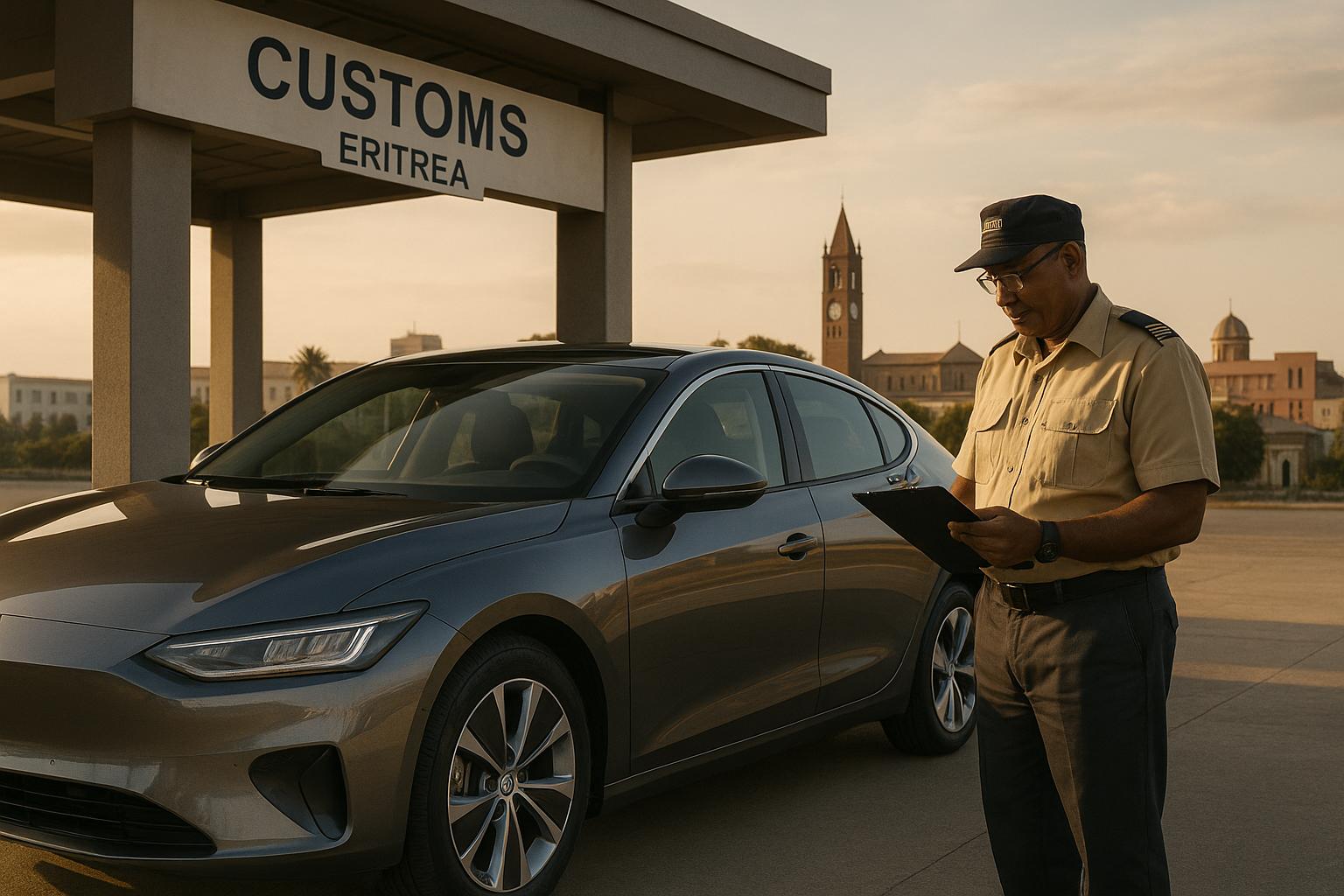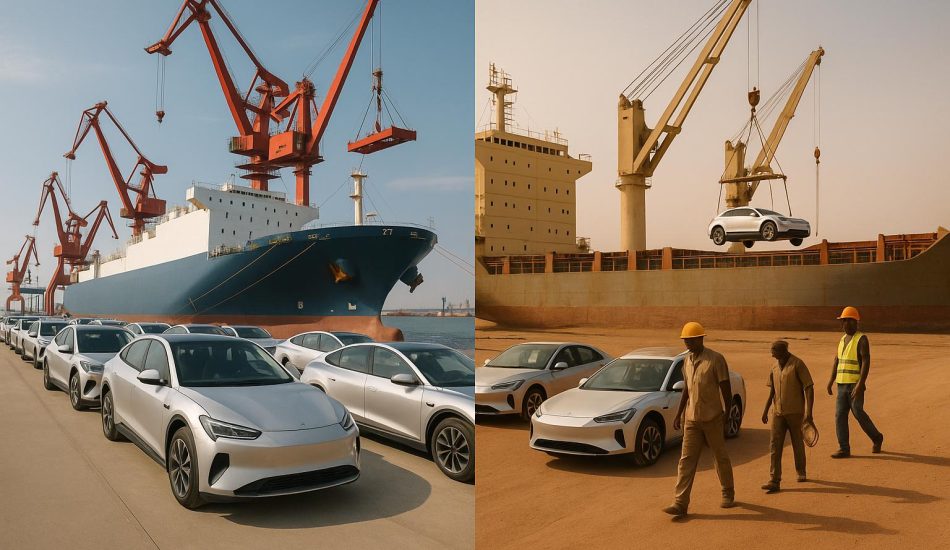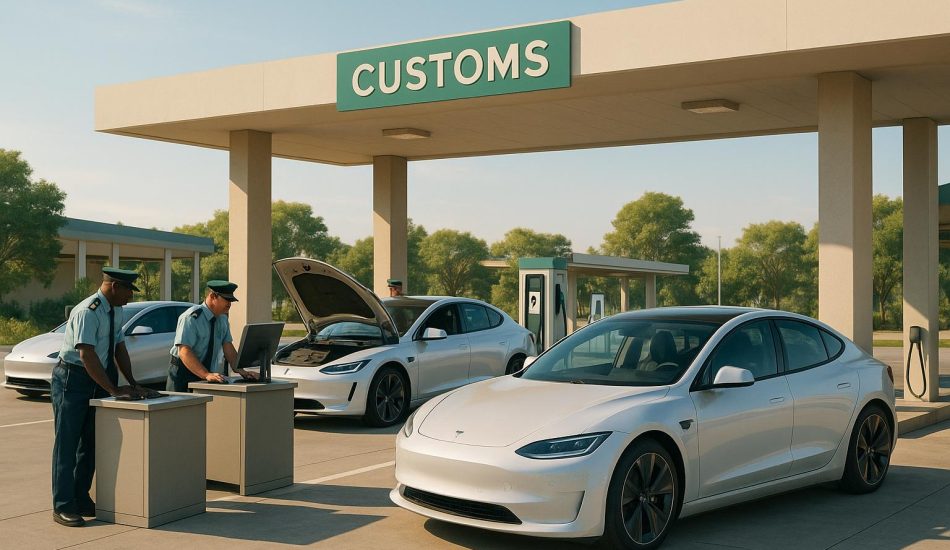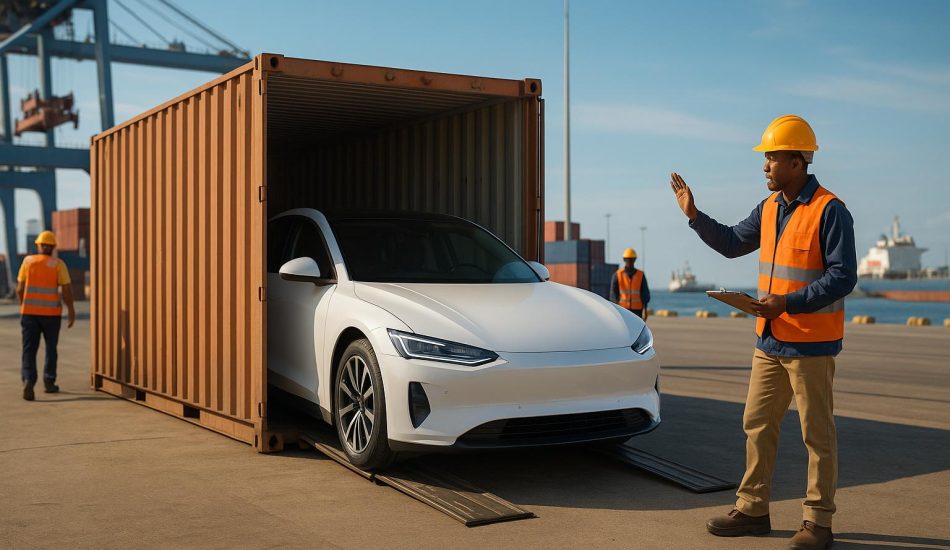
Eritrea is introducing new regulations for electric vehicle (EV) imports starting in 2025, focusing on safety, affordability, and supply chain security. Here’s a quick breakdown of what you need to know:
- Approved EVs: Must meet international safety and technical standards. Popular brands like Tesla, BYD, and Hyundai are expected to comply.
- Restricted EVs: Used EVs older than two model years, luxury EVs priced above $55,000 (cars) or $80,000 (SUVs/trucks), and vehicles with battery components sourced from certain countries (e.g., China, Russia) face limitations or higher duties.
- Import Costs: Tariffs range from 10% (motorcycles) to 20% (passenger cars). Additional VAT, customs fees, and regional trade agreements may apply.
- No Incentives Yet: Eritrea currently offers no tax breaks or subsidies for EV imports.
To import an EV, you’ll need proper documentation, including an import permit, commercial invoice, and safety certificates. Customs inspections and compliance with technical standards like charging protocols (e.g., SAE J1772) are mandatory. Stay updated on policy changes to avoid delays or unexpected costs.
Ethiopia bans importation of non-electric private cars
Eritrea’s EV Import Policy Overview
Eritrea’s government has outlined new guidelines for electric vehicle imports, set to take effect in 2025. These regulations define the conditions under which electric vehicles can be brought into the country, marking a key step in shaping Eritrea’s approach to EV adoption.
Recent Legislative Changes
The 2025 framework is Eritrea’s first major effort to regulate electric vehicle imports. While Eritrea was not included in the EV Readiness Index due to insufficient data, these new rules signal the country’s intent to establish its own standards and policies for EV integration.
Which Vehicles Are Covered
The regulations apply to a wide range of electric vehicles, including passenger cars, luxury models, autonomous vehicles, and those with smart technology. These rules aim to cater to both individual consumers and businesses, such as commercial fleet operators. They also cover EVs equipped with advanced digital systems.
Furthermore, the policy differentiates between various user groups, including individual EV owners, high-end manufacturers, fleet operators, and commercial buyers. This segmentation allows for more specific requirements tailored to the purpose and scale of each import.
Allowed and Prohibited EV Types
To import electric vehicles (EVs), they must meet international safety and technical standards, along with specific eligibility rules. Below is a breakdown of which EV types are permitted and which face restrictions under the outlined policy.
Approved EV Categories
Only EVs that meet international certification standards and provide the necessary documentation are approved for import. Regulatory authorities will provide further details on the specific vehicle types and technical requirements.
Banned or Limited EV Types
- Used Electric Vehicles: To qualify for tax credits, used EVs must be at least two model years older than their purchase year and priced below $25,000. These restrictions ensure imported used vehicles meet current performance benchmarks and remain reliable.
- High-End Luxury Electric Vehicles: New EVs priced above $55,000 for cars or over $80,000 for SUVs, trucks, and vans are subject to additional scrutiny and higher duties. This measure aims to strike a balance between fostering innovation and maintaining affordability.
- Battery Technology Restrictions: Starting January 1, 2025, EVs with battery components or critical minerals sourced from certain foreign entities (including China, Iran, North Korea, and Russia) will no longer qualify for tax credits. This policy is intended to enhance supply chain security and encourage ethical sourcing practices.
These classifications reflect Eritrea’s dedication to ensuring that imported EVs align with modern safety, economic, and supply chain priorities.
Import Costs, Taxes, and Incentives
Bringing electric vehicles (EVs) into Eritrea in 2025 involves specific tariffs, fees, and the possibility of policy adjustments. The overall expense of importing EVs is heavily influenced by these tariffs and associated fees.
Import Duties and Tax Rates
Eritrea imposes standard tariff rates on EVs, determined by their classification. For passenger vehicles like cars and SUVs, the import tariff is set at 20%, while commercial vehicles such as trucks and buses face a slightly lower rate of 15%. Electric motorcycles, however, enjoy a more favorable tariff of just 10%. Additionally, importers from COMESA member countries may benefit from reduced tariffs or even duty-free access, depending on regional trade agreements.
On top of these tariffs, importers should also consider value-added tax (VAT) and customs fees. These charges form the foundation of Eritrea’s fiscal policies related to vehicle imports and play a crucial role in determining the overall cost.
Government Incentives for EVs
At present, Eritrea does not provide any specific incentives or subsidies for importing EVs. Unlike other nations that offer tax breaks or financial support to encourage EV adoption, Eritrea has yet to implement such measures. That said, keeping an eye on government announcements is essential, as future policy shifts could impact the costs associated with EV imports.
EV vs. Gas Vehicle Import Costs
When it comes to tariffs, EVs and gas-powered vehicles face similar rates. The primary cost differences arise from the upfront purchase price of the vehicle and the long-term savings associated with EV ownership. Meanwhile, regional trends highlight a shift in policies that could impact traditional combustion engine vehicles. For instance, Ethiopia plans to introduce a 15% VAT and a 15% excise tax on fuel, which could significantly increase the total cost of owning a gas-powered vehicle over time. These changes underline the growing financial appeal of EVs in the region.
Required Documents and Import Process
To navigate Eritrea’s EV import policies effectively, it’s essential to understand the documentation and steps involved. Importing electric vehicles (EVs) into Eritrea requires careful preparation and compliance with customs regulations. Here’s a breakdown of the key documents and process to help you through it.
Mandatory Import Documents
To bring an EV into Eritrea, you’ll need several documents, including:
- An import permit
- A commercial invoice that outlines the vehicle’s value, specifications, and description
- A packing list
- Health or safety certificates, if applicable
Once you’ve gathered these documents, follow the steps below to complete the import process.
Import Process Steps
- Submit Documents: Start by compiling and submitting all required paperwork to Eritrea’s customs authorities.
- Customs Inspection: Customs will inspect the vehicle to verify compliance with regulations.
- Duties Assessment: After inspection, customs will calculate the duties owed.
- Payment and Clearance: Once duties are paid, customs will issue a release for your vehicle.
- Take Possession: With clearance completed, you can transport your EV from the port or border to its final destination.
Importer Compliance Checklist
Meeting Eritrea’s strict import guidelines requires attention to detail. Here’s how to stay compliant:
- Provide Accurate Information: Ensure all details about the vehicle, including its value and origin, are complete and truthful.
- Use a Customs Broker: A broker can simplify the process and help you avoid costly mistakes.
- Stay Updated on Regulations: Customs rules can change, so regular reviews are essential to prevent delays.
- Pre-Shipment Inspection: Before shipping, arrange an inspection to confirm your EV meets all required standards.
- Plan Transportation: Organize efficient packaging and transportation to ensure a hassle-free import.
sbb-itb-99e19e3
Approved EV Models and Technical Standards
When considering electric vehicles (EVs) for import into Eritrea, it’s crucial to focus on models that align with the country’s import guidelines. While the list of officially approved models is still in development, examples from well-known EV brands that meet international technical standards provide valuable insight.
Compliant EV Models and Brands
Some of the most prominent EV manufacturers produce vehicles that adhere to global standards, making them suitable for import. For example, Tesla has been a leader in the North American EV market since 2012. Models like the Model 3 and Model Y are widely recognized for their advanced safety features and dependable performance.
Chinese automaker BYD has also made a name for itself, gaining attention for its competitive pricing and quality. Other notable brands include Hyundai and Geely, both of which produce vehicles designed to meet established safety and emissions criteria. Many of these brands are listed on platforms like EV24.africa, which provides detailed specifications and transparent pricing.
Another important development for the Eritrean market is the growing adoption of standardized charging systems. Companies like Ford and General Motors have announced plans to implement the North American Charging Standard (NACS), with the first compatible models expected to be available by 2025. This shift is expected to simplify charging infrastructure for importers and enhance compatibility across various EV models.
Technical Standards and Requirements
In addition to brand reputation, meeting specific technical standards is essential for EV approval. Vehicles must comply with internationally recognized charging protocols, such as SAE J1772 for AC charging and SAE J3068 for DC fast charging. Similarly, adherence to IEC standards – like IEC 61851-1 for AC systems and IEC 62196 for connectors – is mandatory.
Battery safety is another critical factor. Electric vehicles need to meet standards for rechargeable energy storage systems (REESS), such as IS 18590:2024 and IS 18606:2024, which address electric powertrain safety. These standards ensure the vehicle’s thermal management and electrical safety during operation and charging.
Charging modes also play a significant role. Compliance with IEC 61851 specifications is required, covering everything from basic household setups (Mode 1) to high-power DC fast charging (Mode 4). Offering multiple charging options ensures flexibility in adapting to existing infrastructure.
With EVs expected to make up one in four cars sold globally by 2025, manufacturers like BYD and Geely are well-positioned to provide affordable vehicles that meet the rigorous technical standards necessary for import into Eritrea.
Final Summary: Allowed vs. Prohibited EVs
With limited information currently available about Eritrea’s 2025 EV import rules, staying informed through official updates is essential. While the exact categories and technical requirements remain unclear, there are a few general guidelines that can help you prepare:
- Adhere to Safety Standards: Ensure the EV complies with international safety standards and comes with complete manufacturer certifications and compliance documentation.
- Consider Age and Condition: The vehicle’s age and condition may influence its eligibility. In 2022, over 80% of imported vehicles in the region were second-hand. Make sure any used EV aligns with Eritrea’s upcoming criteria for imports.
- Plan Financially: Import duties and associated costs can vary based on the vehicle’s condition and compliance status. Check Eritrea’s latest tariff structures through official channels to avoid unexpected expenses.
These factors are crucial for planning your EV import. Addressing them can help you navigate Eritrea’s changing import regulations more effectively.
Stay updated by monitoring official announcements and seeking advice from industry experts. Trusted platforms like EV24.africa can provide valuable guidance to ensure your EV import process aligns with the latest requirements.
FAQs
What international safety and technical standards must EVs meet to be imported into Eritrea in 2025?
To bring electric vehicles (EVs) into Eritrea in 2025, they’ll need to adhere to several important international safety and technical standards. For charging systems, compliance with IEC 61851-1, IEC 61851-23, and IEC 62196 is required to guarantee both compatibility and safe operation. On the battery side, EVs must meet the safety requirements outlined in FMVSS No. 305a, which focuses on the secure design and performance of electric powertrains.
These regulations are in place to make sure imported EVs meet global standards for safety, reliability, and energy efficiency – perfectly aligning with Eritrea’s push for modern and environmentally conscious transportation options.
How will Eritrea’s 2025 EV import rules affect the availability and cost of electric vehicles for consumers and businesses?
Eritrea’s 2025 EV Import Rules
Eritrea’s upcoming 2025 regulations on electric vehicle (EV) imports are set to shape the market in terms of both variety and pricing. These rules could place restrictions on certain EV models or technologies, potentially narrowing the options available to consumers and businesses. On top of that, adjustments to tariffs or compliance requirements might increase import costs, which could make EVs less affordable.
This combination of higher prices and limited choices could slow the adoption of EVs, posing challenges for the growth of electric transportation in the country. That said, businesses and individuals who adapt to these changes and navigate the rules wisely may still find ways to embrace the shift to electric mobility.
How could Eritrea’s new battery technology restrictions impact global EV supply chains and sourcing strategies?
Eritrea’s Impact on the Global EV Supply Chain
Eritrea’s decision to restrict certain battery technologies could create hurdles for the global electric vehicle (EV) industry. By limiting the use of materials like lithium or cobalt – already sourced from a small number of countries – this policy could lead to higher costs, potential shortages, and fiercer competition for these essential resources.
To adapt, manufacturers might focus on diversifying their supply chains, seeking out alternative materials, or ramping up regional production capabilities. These shifts could also spark advancements in battery technology, pushing for solutions that are both more sustainable and locally sourced to keep pace with the growing global demand for EVs.




